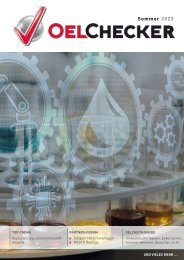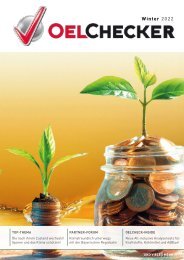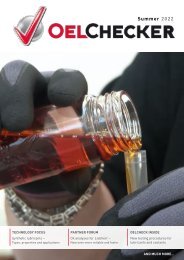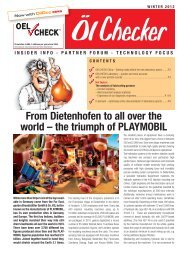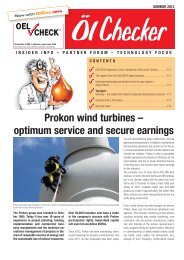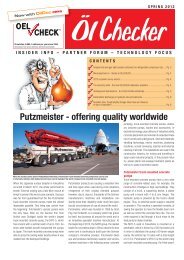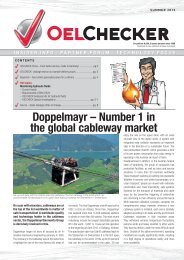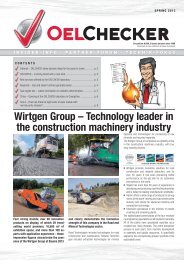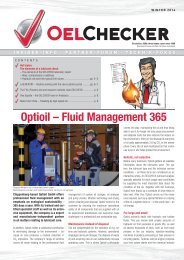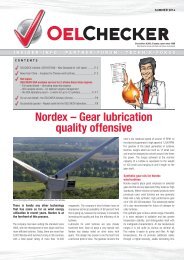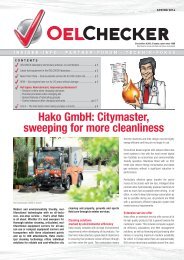OELCHECKER Winter 2022 - English
> HOT TOPIC: Condition-based oil changes – save money and protect the environment > OELCHECK INSIDE: 2022 UN Climate Change Conference / GfT honours Peter Weismann / High-level visit from the USA > TECHNOLOGY: Focus AdBlue – A cleaning agent with no residual alcohol > OELCHECK INSIDE – ALL ANALYSES FROM A SINGLE SOURCE AdBlue – New all-inclusive analysis kits Fuels – Investigations pursuant to DIN now available for almost all types Coolants – New Ultra analysis kit for faults in the cooling system > OELCHECK PARTNER FORUM: Bayerische Regiobahn – Climate- and environmentally friendly travel > FAQ: The tribologists at OELCHECK – Their knowledge and tasks > OilDoc News: OilDoc Conference & Exhibition / Seminar highlights
> HOT TOPIC: Condition-based oil changes – save money and protect the environment
> OELCHECK INSIDE: 2022 UN Climate Change Conference / GfT honours Peter Weismann /
High-level visit from the USA
> TECHNOLOGY: Focus AdBlue – A cleaning agent with no residual alcohol
> OELCHECK INSIDE – ALL ANALYSES FROM A SINGLE SOURCE
AdBlue – New all-inclusive analysis kits
Fuels – Investigations pursuant to DIN now available for almost all types
Coolants – New Ultra analysis kit for faults in the cooling system
> OELCHECK PARTNER FORUM: Bayerische Regiobahn – Climate- and environmentally friendly travel
> FAQ: The tribologists at OELCHECK – Their knowledge and tasks
> OilDoc News: OilDoc Conference & Exhibition / Seminar highlights
Create successful ePaper yourself
Turn your PDF publications into a flip-book with our unique Google optimized e-Paper software.
Fuel analysis kits at a glance<br />
The DIN, ISO or ASTM standards define the requirements – depending<br />
on the product – for the quality of the fuels as well as for checking<br />
their quality. OELCHECK will offer comprehensive analyses for<br />
the following product groups as from January 2023:<br />
■<br />
■<br />
Petrol<br />
Complete scope of analysis pursuant to DIN EN 228.<br />
For unleaded petrol. Also with the addition of up to 10 % ethanol,<br />
such as in Super E5, Super E10 and Super Plus.<br />
Diesel fuels<br />
Complete scope of analysis pursuant to DIN EN 590.<br />
For conventional fossil diesel fuels. Also with the addition of up<br />
to 7 % biodiesel, such as in B7.<br />
Note: Diesel fuel containing biodiesel may be contaminated by<br />
bacteria. These multiply in the area between the fuel and water<br />
resting at the bottom of the tank. Frequently blocked fuel filters<br />
and lines, sludge-like deposits in the tank and the loss of engine<br />
performance are typical signs of diesel being infested with bacteria.<br />
OELCHECK’s additional test for contamination provides a<br />
quick, clear answer as to whether bacteria have formed in the<br />
fuel.<br />
■<br />
GTL Gas-to-Liquids Fuel is an alternative synthetic diesel fuel<br />
produced using natural gas. It burns far cleaner than conventional<br />
diesel and emits significantly less dust and nitrogen oxide. GTL<br />
has a high cetane number (75-80) and therefore boasts higher<br />
combustibility and better combustion quality than fossil diesel.<br />
Where CO 2<br />
is used instead of natural gas as a carbon source to<br />
build up the hydrocarbons, this is referred to as e-diesel. This is,<br />
in fact, carbon-neutral, as the CO 2<br />
needed can be extracted from<br />
the air or separated during an industrial process. This means<br />
that no ’new’ CO 2<br />
is released from fossil sources, and the ’existing’<br />
CO 2<br />
can be reused in a circular process.<br />
HVO is based on hydrogenated vegetable oils, which are converted<br />
into hydrocarbons using a catalytic reaction with the addition<br />
of hydrogen. This is what is known as a second-generation biofuel.<br />
The result is a 100 % fossil-free diesel product made only from<br />
renewable raw materials. Using HVO, an engine’s CO 2<br />
emissions<br />
can be reduced by 65-90 % compared to conventional diesel.<br />
EL heating oil<br />
Complete scope of analysis pursuant to DIN 51603-1.<br />
For conventional EL heating oil and low-sulphur EL heating oil.<br />
■<br />
Synthetic diesel fuels<br />
Complete scope of analysis pursuant to DIN EN 15940.<br />
For synthetic diesel fuels HVO and GTL.<br />
E-fuels<br />
1.4 billion cars and a huge number of commercial vehicles with<br />
internal combustion engines remain on the road around the<br />
world. Even though a vehicle’s largest CO 2<br />
emissions throughout<br />
its life cycle occur during production, it should be powered<br />
by alternative, carbon-neutral fuels where possible. E-fuels or<br />
synthetic fuels are increasingly the fuel of choice to move the<br />
running of such vehicles away from fossil fuels. Both e-fuels<br />
and synthetic fuels are expected to play an increasingly important<br />
role in protecting the planet, and as such OELCHECK is offering<br />
all-inclusive analyses for synthetic diesel fuels.<br />
Synthetic fuels are chemically produced or synthesised and can,<br />
in principle, originate from different sources.<br />
■<br />
■<br />
■<br />
AvTur<br />
Complete scope of analysis pursuant to ASTM D1655.<br />
For aviation fuel for jet aircraft, turboprop jets and helicopters.<br />
Marine fuels / Distillate fuels<br />
Complete scope of analysis pursuant to ISO 8217.<br />
For marine fuels in classes DM or DF.<br />
These middle distillates are comparable to EL heating oil and<br />
diesel fuel. They are used in engines on cruise ships and inland<br />
waterway vessels.<br />
Marine fuels / Residual fuels<br />
Complete scope of analysis pursuant to ISO 8217.<br />
For marine fuels of the residual fuel type.<br />
Any leftover fuel from refinery processes is referred to as residual<br />
or heavy fuel oil. These residual fuels are mainly used in<br />
large marine engines.<br />
Sample quantities, containers and returns<br />
The fuel all-inclusive analysis kits come with aluminium sample<br />
bottles. Each container has a capacity of one litre. However, two litres<br />
are required for running a petrol analysis. These analysis kits<br />
therefore go out to customers with two one-litre bottles.<br />
It is essential to observe the following when filling:<br />
Please fill the sample bottles to the brim!<br />
There must be no free space present to allow the fuel to release<br />
vapours in the aluminium bottle. If space is present, we<br />
will be unable to determine the vapour pressure correctly in the<br />
laboratory.<br />
The new fuel all-inclusive analysis kits are valuable tools for incoming<br />
goods and overall quality control. They can also detect any<br />
contamination that may affect the operation of filters, injectors and<br />
other components. In practical terms, too, the principle of getting<br />
all your analysis kits from a single source simplifies the invoicing<br />
modalities and helps you maintain a clear overview of your costs.<br />
10




